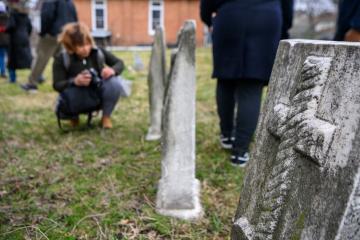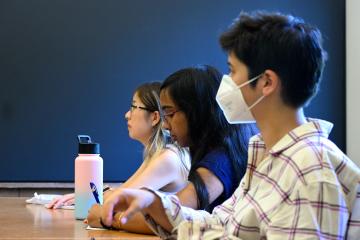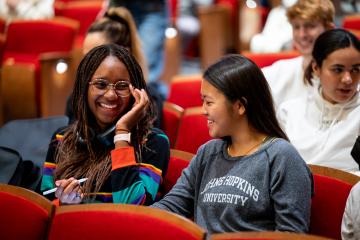This article originally appeared in the Spring 2023 issue of Arts & Sciences Magazine
When college is in your (very) distant past, it's an uncommon joy to sit in on a Krieger School of Arts and Sciences class now and then and call it work (I'm a writer in the school's Office of Communications). It's a rush of hope to listen to students who understand so clearly what this world needs, and who weave in such compassion as they grapple with solutions. I feel my own thinking elevate as I get swept up in the passion of professors who can't help themselves; they so want the questions they live for to light a fire for their students, too.
And the things I learn. Why does it feel like I would appreciate college so much more now?
Earlier this semester—which marked the launch of the First-Year Seminar as a Krieger School requirement—I sat in on six of these intimate, satisfactory/unsatisfactory discussion courses, for one session each. The idea of the seminar is to introduce brand-new undergrads to the intellectual discourse of higher education, to create mentoring bonds with faculty, and to build potentially lifelong cohorts of peers; and I wanted to see how that unfolds.
In preparation, I read six syllabi. I watched a film for one class and reviewed a set of poetic expressions for another. I even got called on in one of them (I got the answer wrong).
Here's some of what I learned.
The Natural History of the Homewood Campus
A combination of observational and sampling techniques to demonstrate how ecologists collect data about plants, insects, and other organisms.
On a warm and sunny Thursday afternoon, 11 students cluster around shovels and jugs of mustard solution in the grassy area between Olin Hall and the Early Learning Center. When you want to see who's living underground, one method is to drench the soil with diluted mustard, which makes the inhabitants slither or scamper to the surface. Today, those seeking escape are mostly worms, ants, isopods, and centipedes.
"I think you decapitated this one," one student gently accuses another. "Oh, no, he's just short." Before trekking outside, soil ecologist Katalin Szlavecz had given us a crash course in what she called "the wonderful world of invisible biodiversity." Soil contains 25% of the global biodiversity, she said, and a single gram can hold millions of individual organisms and several thousand species of bacteria. Up to 90% of living organisms spend part or all of their lives underground.
What worms can tell us
Under a tree, we gather around Szlavecz, a research professor in the Morton K. Blaustein Department of Earth and Planetary Sciences. She's holding aloft an earthworm whose brownish—not pinkish—color indicates that it lives inside the soil. Almost all local earthworms are non-native, she notes.
During the last Ice Age, North America was glaciated as far south as Pennsylvania, Szlavecz tells us. Many creatures have since migrated back, but earthworms are slow dispersers, so native ones can't yet be found this close to the glacial line.
Instead, the types most common on the East Coast—and also in Northern California—are European natives. Ships would arrive from Europe in coastal U.S. ports containing soil used as ballast. When the soil was shoveled out to make room for cargo, the worms burrowed inside found themselves with a new home.
Moving through soil is both painful and energy-intensive for the worms, so they don't go far. "For them to tunnel through soil is almost what it would be like for us to tunnel through glass shards," Szlavecz says.
I ask Kieran Manjrawala what he thinks he might take from this class. "Being inspired to look into nature more closely, more in-depth," he replies. "Also, the skills to use the different tools to explore and look at the nature around you, even if it's your backyard."
Citizenship and Society in the U.S.
An investigation into the idea and practice of popular sovereignty in the contemporary United States.
In the hall before class, I ask TC Taylor about the course. He's pre-med and plans to major in neuroscience.
"Going into this class, I wasn't very knowledgeable about modern democracy, how it fits into my life, what my responsibilities are as a citizen and as a student of higher education," he says. "And I feel like it's multi-faceted, because I have a responsibility as a citizen—as I'm learning now—to understand the environment that I'm in, and to impact it in a way that I think would be beneficial for me and my community. We're learning this through philosophical discussion, through looking at what the framers had in mind with our constitution and with our democracy, and how that fits for us as a whole. So if all of us can better understand that, then maybe we can help advance our democracy."
Boom.
Connecting from Afar
Through the powers of Zoom, the course includes 12 students sitting around a table in Mergenthaler Hall, and 12 more around a remarkably similar table 350 miles away, at Williams College in Massachusetts. A collaboration between the schools, the two seminars meet frequently via videoconference to broaden perspectives and allow each group to share real-time research on the politics of its institution's region. A combined group of students opens the session with a brief presentation on Tea Party Patriots and constitutional originalism.

Image caption: Andrew Perrin leads a discussion of the idea of sovereignty in the contemporary U.S.
Image credit: Will Kirk / Johns Hopkins University
"There's an uneasy tension between the right of people to govern themselves and the protection of rights for minorities, isn't there?" summarizes Andrew Perrin, SNF Agora Institute Professor of Sociology. "There's the right to make policy and the right of people to be untouched by policy. Sovereignty is built upon the same rights it can't touch."
Opinions of Democracy
Discussion turns to one of the readings, which holds that democracy rests on an illusion. Opinions vary, points build: "Illusion has been part of other forms of government, too." "Government depends on propaganda about government being helpful." "Authority is limited by its own fictions; since it's supposed to be self-evident, it can't be modified easily."
"'The people' started as a fiction, but it's up to us to make it a reality, just like democracy itself," another student observes.
Someone else asks what makes the U.S. different from China or Russia, if everything rests on propaganda. Is it better propaganda? the class wonders. Is it that democracy is flawed, but serves as the flawed voice of the people? Is it about evidence? Better outcomes?
There are more questions than answers. And it gives me confidence that, yes, Taylor and his peers can help advance democracy.
Global Cinema in the 21st Century
During in-class discussion, consider what makes a particular film noteworthy, what the director seems to think about his/her/their national context, and how local issues intersect with broader questions about the human condition.
Every Tuesday evening, this class watches a movie together. The next day, they talk about it.
The movie this time was Sweet Bean, a 2015 Japanese story in which dorayaki—pancake sandwiches with a bean-paste filling—play a central role. There's a discontented baker who reluctantly hires an elderly woman who ends up transforming his world, but no spoilers because I really recommend that you watch this one for yourself.
Ten or 15 minutes go by before Tokue— the elderly employee—enters the movie, says historian Laura Mason, a teaching professor in the Department of History and the Program in Film and Media Studies. So why do we consider Tokue a central protagonist?
"Everything she says is intertwined in the story," someone says. "She talks about wind and then we see the young girl in the wind. She influences all the characters she meets."
As the movie unfolds, we learn that Tokue's life has been painful and bleak by most standards. The group wrestles to reconcile this with the character's uplifting presence. "What else does Tokue have? What did you talk about at dinner last night that makes your first semester at Hopkins easier?" Mason probes.
"Having people around," someone says.
"When you find out you're not alone, things are easier," says someone else.
A Reflection of Life
After class, Rachel Oyewo tells me that the movie reminded her of grit, a character trait she discussed at a recent session of Arrive and Thrive—an optional, one-credit course for incoming students—after viewing a TED Talk about it.
"I believe movies intertwine with our lives all the time," continues Oyewo, who is such a film fanatic that her friends sometimes question her choice to major in molecular and cell biology. "I like how you can relate to a movie even if you don't share a similar experience. Maybe the cinematography reminds you of something else in your life."
As the end of the session nears and the animated discussion begins to flag, Mason invites us to stand, stretch, and jump. When she allows us to sit back down, most of us don't. The discussion turns lively again.

Image caption: Students in Global Cinema in the 21st Century discuss what makes films noteworthy, and how local issues intersect with the broader human condition.
Image credit: Will Kirk / Johns Hopkins University
When Chemistry Changed History
A deep dive into chemical discoveries that changed history, discussing how they work and their impact on society.
The syllabus promised topics ranging from dirt warfare to the link between gunpowder and workers' rights. But what caught my eye was the session on "how your cat biochemically domesticated you."
For background, chemist Eric Hill reminds us that cats were worshipped in ancient Egypt because they kept the plague away. Infected rodents came for the accumulating garbage and then infected humans by biting them, and the introduction of cats brought down the rodent population.
"You have plagues, you have cats, you have less plague. It's the sort of thing you notice," says Hill, senior lecturer in the Department of Chemistry.
The Dopamine Parasite
Today, a parasite called Toxoplasma gondii lives in birds and rodents around the world. It also lives in one-quarter to one-third of humans. But its very favorite place is in the guts of cats, because that's the only environment that allows it to reproduce sexually.
The parasite can cause symptoms in humans that include muscle weakness and seizures. It also raises our levels of dopamine, which Hill describes as the happy drug that's associated with love. The chalkboard fills with drawings of molecules.
It's been shown that elevated levels of dopamine cause infected mice to lose their fear of cats, who then effortlessly eat them. It's a clever way for the parasite to enter as many cat guts as possible, Hill says.
So, the thinking goes, does the parasite do the same thing in humans—raise our dopamine to make us love cats more, take better care of them, and bring more of them home—creating yet more opportunities for parasite reproduction?
"It is absolutely impossible to say definitively, but my educated guess is there is no way this thing is not increasing our affinity for cats. If it makes mice stupid enough to be eaten by cats, it probably has some sort of impact on us," Hill says.
Keeping it Lively
Hill describes himself as "as close to a crazy cat guy as you can get," and offers plenty of anecdotes to prove it. He once spent 40 hours straight in his lab to synthesize the rare antibiotic his sick cat needed to live. He refers to cats as "magic murder machines."
I kept looking around to see if everyone else found him as funny as I did, and there was plenty of amusement around the room.
"The digressions allow them to pay attention," Hill tells me after class.
Heart Matters
To the human imagination, the heart is more than a muscle and thumping pump keeping us alive.
This class has read cardiology articles in medical journals and listened to an album of ambient chamber music inspired by the composer's heart surgery. They are in the middle of a book—authored by brothers who are a novelist and a cardiologist—that draws on history, science, religion, popular culture, and literature to illuminate the heart's physical and figurative aspects. They had a guest lecture on emergency intervention by a member of the Boston MedFlight Critical Care Transport Team.
Pre-meds often take this course, notes Evelyne Ender, who taught previous iterations before First-Year Seminars came into being. "The spirit of the course is one where I try to encourage students to have a new kind of curiosity and inquisitiveness," says Ender, a senior lecturer in the Department of Comparative Thought and Literature.
Many meanings of heart
On this day, I sit behind a student who has tied a friendship bracelet to her backpack zipper, white with tiny red hearts marching down it.
The students categorize heart-related expressions they've gathered, placing "heart of gold" in the altruism group, for example, and "give one's heart away" under love. Many of the students are multilingual, and some offer English translations of expressions in other languages. An Urdu expression meaning "to work hard in the most difficult situations" has its origins in the idea that the human heart works hard to keep pumping blood through our veins, one student shares.
The class has also read three poems, each of which has something to say about a literal or metaphorical heart.
It makes sense to me—
that the lips, the open
ah of the mouth
is shaped more like a heart
than the actual human heart.
reads part of "Heart," by Sally Bliumis-Dunn.
"The narrator definitely has a lover that they're very passionate about," remarks one student. She adds that the poem brings to mind her father, who always says that when he thinks of her mother, he sees everything through heart-shaped glasses.
Jennifer Izaguirre Martinez, who is pre-med, says the class touches on her varied interests and on the way she hopes to practice medicine in the future.
"I really love writing, I love literature, so it's a genuinely nice combination that I don't think I would get somewhere else. I think the ability to analyze text and engage in informed discussions is crucial for any career," she says. "In Heart Matters, we discussed the inequities that exist within our current health care system; the importance of being proactive, as opposed to reactive, in fighting illness. I want to be the kind of physician who is aware of these gaps and works to lessen their impact. I want my career to fuse biology, communications, and—most importantly— attentiveness to the well-being of others."
The Right to the City—Race, Class, and Struggle in Baltimore
Protests against policing and inequality, as well as attempts to roll back societal shifts, all have the city as their core. While some suggest these struggles represent larger struggles over the relationship between labor and capital, Black Radical thinkers connect these struggles to anti-Black racism.
In a previous session, this class learned about the Black Butterfly and the White L, the terms Lawrence Brown—a research scientist at Morgan State University—coined to describe geographical patterns of historical and ongoing segregation in Baltimore.

Image caption: Maps help students explore city-based struggle against anti-Black racism
Image credit: Will Kirk / Johns Hopkins University
Today, students share photos they took that reflect the Black Butterfly. We see images of colorful graffiti, gentrification, abandoned buildings.
"You know what I would have taken a picture of? One thing: a bike lane," says Lester Spence, professor in the Department of Political Science. It's almost impossible to find bike lanes in the Black Butterfly, Spence points out, which highlights Baltimore's priorities in allocating resources.
"A bike lane takes a valuable resource—the road itself—and shares space between two populations," Spence says. "That resource can be shared anywhere in city. But by concentrating bike lanes in the White L, that suggests there's only a specific demographic that's worthy of that resource."
Areas of Influence
The class goes on to discuss how spending decisions are made in Baltimore and where the money comes from, and whether any of that changed after the uprising following the 2015 death of Freddie Gray while in police custody. An article they've read suggests it hasn't.
The article ranks the influence on spending wielded by various players, including corporations, foundations, city government, and higher education institutions. One thing that did change after the uprising, Spence says, is that many of those players became more interested in issues related to poverty. But they haven't changed their market-based approach to solutions, he adds. So a neighborhood struggling with low investment might get new housing, but the original residents are priced out instead of benefitting from it.
"Another solution would be to increase the quality of resources in poor neighborhoods regardless of who lives there," Spence says.
Renard Simmons Jr., a pre-med biology major from Galveston, Texas, says the class is putting him more in tune with the community, showing him how to get involved in a Baltimore that is much bigger than Hopkins, and teaching him where it's safe and unsafe for him to go as a young Black man. "I really enjoy this class," he tells me. "It helps me gain knowledge of the Baltimore culture and what the right to the city is. The more years that I live here, it's going to show me how I can be more involved on and off campus."
Posted in Student Life
Tagged krieger school, student life











